
The Doctor V64 is a development and backup device made by Bung Enterprises Ltd that is used in conjunction with the Nintendo 64. The Doctor V64 also had the ability to play video CDs and audio CDs. Additionally, it could apply stereo 3D effects to the audio.

The Super Nintendo Entertainment System, commonly shortened to Super Nintendo, Super NES or SNES, is a 16-bit home video game console developed by Nintendo that was released in 1990 in Japan and South Korea, 1991 in North America, 1992 in Europe and Oceania and 1993 in South America. In Japan, it is called the Super Famicom (SFC). In South Korea, it is called the Super Comboy and was distributed by Hyundai Electronics. The system was released in Brazil on August 30, 1993, by Playtronic. In Russia and CIS, the system was distributed by Steepler from 1994 until 1996. Although each version is essentially the same, several forms of regional lockout prevent cartridges for one version from being used in other versions.

A video game console is an electronic device that outputs a video signal or image to display a video game that can be played with a game controller. These may be home consoles, which are generally placed in a permanent location connected to a television or other display devices and controlled with a separate game controller, or handheld consoles, which include their own display unit and controller functions built into the unit and which can be played anywhere. Hybrid consoles combine elements of both home and handheld consoles.
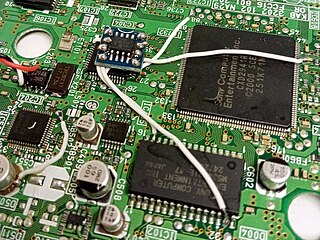
A modchip is a small electronic device used to alter or disable artificial restrictions of computers or entertainment devices. Modchips are mainly used in video game consoles, but also in some DVD or Blu-ray players. They introduce various modifications to its host system's function, including the circumvention of region coding, digital rights management, and copy protection checks for the purpose of using media intended for other markets, copied media, or unlicensed third-party (homebrew) software.
A regional lockout is a class of digital rights management preventing the use of a certain product or service, such as multimedia or a hardware device, outside a certain region or territory. A regional lockout may be enforced through physical means, through technological means such as detecting the user's IP address or using an identifying code, or through unintentional means introduced by devices only supporting certain regional technologies.
The Homework First is a combination lock parental control device for the Nintendo Entertainment System made by SafeCare Products, Inc. of Dundee, Illinois and Master Lock. The lock features a "Self-Setting" combination that attaches to the open bay of a front-loading NES-001 system via a screw hole below the cartridge slot which enables the lock to grab the console like a vise to prevent both the insertion of cartridges and the removal of the device. Around 25,000 units were claimed to have been sold.

Wisdom Tree, Inc. is an American developer of Christian video games. It was an offshoot of Color Dreams, one of the first companies to work around Nintendo's 10NES lockout chip technology for the Nintendo Entertainment System. Color Dreams formed the Wisdom Tree subsidiary in 1990 in an effort to circumvent Nintendo's restrictions against publishers of unlicensed video games for the NES by selling their games at Christian book stores which was not subject to pressure by Nintendo.
In video game parlance, a famiclone is a hardware clone of the Family Computer/Nintendo Entertainment System. They are designed to replicate the workings of, and play games designed for, the Famicom and NES. Hundreds of unauthorized clones and unlicensed game copies have been made available since the height of the NES popularity in the late 1980s. The technology employed in such clones has evolved over the years: while the earliest clones feature a printed circuit board containing custom or third party integrated circuits (ICs), more recent (post-1996) clones utilize single-chip designs, with a custom ASIC which simulates the functionality of the original hardware, and often includes one or more on-board games. Most devices originate in China and Taiwan, and less commonly South Korea. Outside China and Taiwan, they are mostly widespread across emerging markets of developing countries.
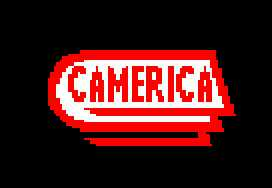
Camerica was a Canadian video game company founded in 1988. It released various unlicensed video games and accessories for the Nintendo Entertainment System, such as the Game Genie, and was the North American publisher for British developer Codemasters.
Tengen Inc. was an American video game publisher and developer that was created by the arcade game manufacturer Atari Games for publishing computer and console games. It had a Japanese subsidiary named Tengen Ltd..
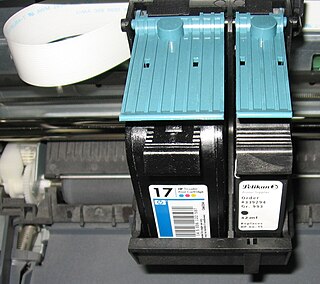
An ink cartridge or inkjet cartridge is a component of an inkjet printer that contains ink to be deposited onto paper during printing. It consists of one or more ink reservoirs and can include electronic contacts and a chip to exchange information with the printer.
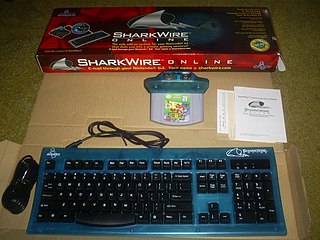
SharkWire Online is a specialized GameShark device with a serial port and modem added, accompanied by a now-defunct dialup Internet portal service. Launched in January 2000, it was sold only in the US, by InterAct which is most famous for its GameShark and Dexdrive. This unlicensed platform was the only Nintendo 64 online service to have been released other than Nintendo's official Randnet service which had already been released only in Japan in December 1999.

The Nintendo Entertainment System (NES) is an 8-bit home video game console produced by Nintendo. It was first released in Japan on July 15, 1983, as the Family Computer (Famicom). It was released in US test markets as the redesigned NES in October 1985, and fully launched in the US the following year. The NES was distributed in Europe, Australia, and parts of Asia throughout the 1980s under various names. As a third-generation console, it mainly competed with Sega's Master System.
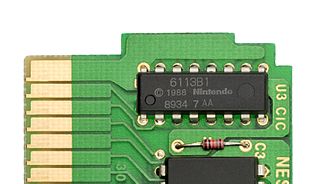
The Checking Integrated Circuit (CIC) is a lockout chip designed by Nintendo for the Nintendo Entertainment System (NES) video game console in 1985; the chip is part of a system known as 10NES, in which a key is used by the lock to both check if the game is authentic, and if the game is the same region as the console.
American Game Cartridges (AGC) was an American video game developer and publisher established as a subsidiary of ShareData in 1990. Like ShareData, American Game Cartridges was headquartered in Chandler, Arizona. AGC published three video games for the Nintendo Entertainment System (NES) in 1990.

Nintendo 64 Game Pak is the brand name of the ROM cartridges that store game data for the Nintendo 64. As with Nintendo's previous consoles, the Game Pak's design strategy was intended to achieve maximal read speed and lower console manufacturing costs through not integrating a mechanical drive, with a drawback of lower per dollar storage capacity compared to a disk. From the console's first year from late 1996 through 1997, Game Pak sizes were 4 to 12 megabytes with a typical third party retail price of US$75.99, then available in 32 megabytes in 1998, and finally 64 megabytes from 1999 onwards.

The Nintendo Entertainment System Game Pak is the software storage medium for the Nintendo Entertainment System, part of the Nintendo's Game Pak series of ROM cartridges.











